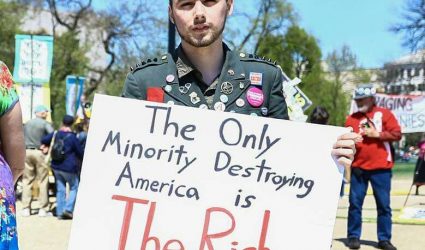The World’s Protesters Want to Soak the Rich, But That’s Not All

(Bloomberg) – Sharp divisions between the rich and poor are fueling a global wave of unrest — but that’s just one of the grievances driving people onto the streets, according to a leading scholar of economic inequality.
Latin America’s yawning wealth gap helps explain the protests that exploded in Chile last month, says Branko Milanovic, the former World Bank economist whose “elephant chart” — named for the shape of its curve — was celebrated for revealing the winners and losers from globalization.
But in the Middle East, the other region suffering widespread unrest and hardly any economic growth, he sees a different picture — with anger directed at political systems that are shielding elites from any kind of change.
Left Behind
Protests have forced leaders in Lebanon and Algeria to resign, toppled the regime in Sudan and pushed Iraq’s government to the brink of collapse. “I don’t think we can put out a blanket story of inequality” to explain them all, says Milanovic, author most recently of “Capitalism, Alone” and a professor at the City University of New York.
There’s also a “a sense of exclusion from any sort of meaningful decision-making, a certain fatigue,” he says. “People feel that nobody cares about them, their political representatives are either busy making themselves rich, or they’re too globalist.”
Unrest in Latin countries like Chile and Ecuador has targeted market-friendly governments over measures they’ve taken that raise the cost of living for people who can afford it least. Argentinians just kicked out a president who’s been imposing austerity, voting instead for a left-populist who promised a more equal economy.
Two Types of Inequality
Wealth gaps between countries are much sharper in the Middle East, which contains some of the world’s richest economies — small petro-states in the Persian Gulf — as well as very poor ones like Yemen. That’s why it ranks high for inequality in studies that treat the region as a whole.
World Leader?
Piketty-led study found the Middle East had the highest share of income going to the top 10% of earners
But within individual Mideast countries, inequality is generally lower than in Latin America. Energy-rich governments often distribute a chunk of the revenue among their citizens (non-citizens in the Gulf states, like the migrant laborers who built the skyscrapers of Dubai or Abu Dhabi, don’t get a slice of the pie).
Algeria, for example, is among the more egalitarian countries, judging by the latest World Bank numbers. Still, Algerians have been protesting throughout 2019 — first against a long-serving president, who ended up standing down, and then targeting a wider political system dominated by cliques of army officers, businessmen and party bosses.
‘They Don’t Care’
Latin Americans can vote to change policy — and they’ve been doing it a lot lately, as power swings between left and right.
But Mideast regimes like Algeria’s spark public anger by offering the form of democracy without its substance, says Milanovic. “They call you for elections, but essentially they don’t care how you vote.”
Another kind of Mideast regime, typified by Lebanon and Iraq, is essentially the product of war. Conflicts among religious or ethnic groups were resolved by granting a stake in government to all of them — or at least to elites within each group, who are now accused by protesters of enriching themselves and their clients.
Systems like this encourage corruption because they’re based on more-or-less permanent coalitions, which can’t be disrupted without risking a slide back into conflict, according to Milanovic. He was born in the former Yugoslavia, and says he’s seen similar dynamics at work in fragile Balkan states. “The only way they can exist is essentially by legalizing plunder on an ethnic or religious basis.”
Global Winners
Milanovic is famous for taking the study of income distribution beyond individual countries or regions, and mapping how it looks when you treat the world economy as a whole.
Elephant’s Trunk
Milanovic showed which income groups prospered, and which ones stagnated, during two decades of globalization. The message of his elephant chart was that the world’s middle class — many of them in fast-growing Asia — have done well out of globalization. The next bracket above, mostly low- and medium-income people in developed economies, saw virtually no gains — while the richest raked it in.
Milanovic says he’s working to update the story through about 2014. It will likely show that “the top 1% doesn’t quite have the elevated trunk that it had,” he says. Wealthier people in developed countries, mainly the U.S., have “incomes that depend on the stock market, dividends, interest, and they were affected by the crisis.”
His problem is that even the update will be out of date. Distributional data arrives with a lag so by the time it’s all in, says Milanovic, the best he can do is capture the world economy as it was a few years earlier.
And since then, he says, the elephant’s trunk has probably perked up again. “It’s very likely that the recent period in the U.S., with tax cuts, has given a boost to the top 1%.”

